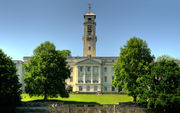East Midlands
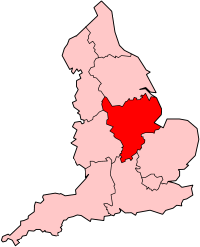 East Midlands region shown within England |
|
| Geography | |
|---|---|
| Status | Region |
| Area — Total |
Ranked 4th 15,627 km² 6,033 sq mi |
| NUTS 1 | UKF |
| Demographics | |
| Population — Total — Density |
Ranked 8th 4,172,179 (2001) 267/km² |
| GDP per capita | £17,698 (5th) |
| Government | |
| HQ | Nottingham (GO) & Melton Mowbray (LALB) |
| Leadership | East Midlands Leaders' Board |
| Regional development | EMDA |
| European parliament | East Midlands |
| Website | |
The East Midlands is one of the regions of England and consists of most of the eastern half of the traditional region of the Midlands. It encompasses the combined area of Derbyshire, Leicestershire, Rutland, Northamptonshire, Nottinghamshire and most of Lincolnshire. A looser definition of the East Midlands would include the City of Peterborough (once part of Northamptonshire but now Cambridgeshire), Burton upon Trent in Staffordshire and north Lincolnshire .
Contents |
Geography
The highest point in the region is Kinder Scout, in the Derbyshire Peak District at 2,088 ft (636 m). The geology of the region includes mostly limestone, and has the East Midlands Oil Province. Charnwood Forest has much volcanic rock being around 600 million years old, and is a good source of granite. The centre of the East Midlands area is roughly between Bingham and Bottesford. The geographical centre of England lies in Higham on the Hill in west Leicestershire, very close to the East Midlands / West Midlands boundary. Several towns in the southern part of the region including Market Harborough, Desborough, Rothwell, Corby, Kettering, Thrapston, Oundle and Stamford are located in the former Rockingham Forest, a huge forest which was at one time a designated hunting forest used by English kings and queens since the time of William the Conqueror who first designated the forest as a royal hunting area.
Governance
Financial funding decisions for the East Midlands (usually public construction schemes) is taken by the East Midlands Leaders' Board, based in Melton Mowbray. It was not an elected body but is made up of representatives of local government in the region. The East Midlands Development Agency is based next door to the BBC on London Road in Nottingham, and now takes all funding decisions for the East Midlands. Economic development in thr region is led by the East Midlands Development Agency. A Government Office for the East Midlands exists to coordinate functions of Central Government in the region.
Population and settlement
| England |
.svg.png) This article is part of the series: |
|
|
|
Government
Law and justice
England in the UK
England in the EU
Local government
|
|
Other countries · Atlas |
Its main settlements are Chesterfield, Derby, Kettering, Leicester, Lincoln, Loughborough, Mansfield, Northampton and Nottingham. Leicester is officially the largest city in the region and the largest conurbation is the Nottingham Urban Area.
Transport
Road
The M1 motorway serves all of the county towns with the exception of Lincoln. In the east, the A1 is an important, often overcrowded route for the east-coast ports and is important for supplying much of the UK's agricultural production. The A46 follows a route which, since Roman times, provided a connection between the south west and north east of the region, although around Newark, it has difficulty coping with capacity. Since June 2009,[1] a seventeen mile section is being dualled to make the route effectively dual carriageway between the M1 and A1. It will open in 2012. East-west routes by road in the region are essentially single-carriageway roads (A57, A52 and A47), with only the dual-carriageway A14 skirting the northern part of Northamptonshire. The dual-carriageway A43 connects the East Midlands with southern England.
Airports
East Midlands Airport in North West Leicestershire is situated between the three main cities of Derby, Leicester and Nottingham.
Smaller airports include Retford Gamston Airport, Nottingham Airport (at Tollerton), Sywell Aerodrome, Bruntingthorpe Aerodrome, and Leicester Airport. Although just outside the region, Robin Hood Airport Doncaster Sheffield (former RAF Finningley) was partly in Nottinghamshire before 1974; easyJet moved all of its routes at EMA to the airport in late 2009. EMA is now mainly a hub for Ryanair and bmibaby.
Railway
Two of the north-south mainline railways serve the region, The Midland Main Line (operated by East Midlands Trains) in the west from St Pancras and the East Coast Mainline (operated by East Coast) from King's Cross in the east. Both companies operate high-speed trains to London. The cross-country route eventually merges with the ECML north of Leeds, and the ECML is a more long-distance, and quicker north-south route. It is cheaper, and sometimes quicker, for Nottingham rail passengers to go to London via the ECML. The ECML is now run by the nationalised East Coast, with other smaller companies. Corby since February 2009 has had its station (closed since 1966), and East Midlands Parkway opened in January 2009.
The main south-west to north-east Cross Country Route (MR) (operated by Arriva plc) runs through Birmingham and Derby also the West Coast Mainline goes into Northampton and Long Buckby in Northamptonshire run by London Midland and sometimes Virgin Trains call at Northampton & Chiltern Railways and First Great Western provide services to Kings Sutton in Northamptonshire on the Chiltern Main Line.
East-west routes are provided by the Nottingham - Skegness, Liverpool - Norwich (through Nottingham), and Birmingham - Stansted Airport (through Leicester) routes; these last two routes are the essentially the only east-west routes in the section of England between Sheffield and London, both routes meeting at Peterborough.
Water

The Trent is a navigable river, and is used to transport goods to the Humber, and passes by many power stations.
Transport policy
As part of the transport planning system the Regional Assembly is under statutory requirement to produce a Regional Transport Strategy (RTS) to provide long term planning for transport in the region. This involves region wide transport schemes such as those carried out by the Highways Agency and Network Rail.[2]
Within the region the local transport authorities carry out transport planning through the use of a Local Transport Plan (LTP) which outlines their strategies, policies and implementation programme.[3] The most recent LTP is that for the period 2006-11. In the East Midlands region the following transport authorities have published their LTP online: Derbyshire,[4] Leicestershire.[5] Lincolnshire,[6] Northamptonshire,[7] Nottinghamshire[8] and Rutland U.A..[9] The unitary authorities of Derby,[10] Leicester[11] and Nottingham[12] have each written a joint LTP in collaboration with their respective local county councils.
History
Danelaw and the Anglo-Saxons
A historical basis for such an area exists in the territory of the Corieltauvi tribe. When the Romans took control of the region, they made Leicester its capital, then named Ratae Corieltauvorum. The region also corresponds to the later Five Burghs of the Danelaw, and the eastern half of the Anglian Kingdom of Mercia.
Scientific heritage
The first practical demonstration of radar was near Daventry in 1935.
Industrial heritage
The region can claim the world's first factory, making textiles at Lea Bridge owned by John Smedley; it is part of the region's only World Heritage Site. Lincoln was the site of the first tank, and Grantham the first diesel engine. The jet engine was first developed in the region in Lutterworth and Whetstone, with the VTOL engine also developed at Hucknall. The first jet aircraft flew from RAF Cranwell in May 1941.
World War 2
Most of the area was protected by only one RAF station, RAF Digby near Sleaford, part of No. 12 Group RAF and controlled from RAF Watnall. Northamptonshire had RAF Wittering. In the region, it was only Nottingham that was heavily bombed during World War 2's Blitz, due to its large Royal Ordnance factory. However much of Germany's aerial obliteration was directed from the region, with two bomber groups in Lincolnshire, and a few squadrons in Nottinghamshire.
Regional governance
The current government office region was created in 1994. Government funding decisions moved from Melton Mowbray (EMRA) to Nottingham (emda) in April 2010.
Demographics
For teenage pregnancy rates in the region, of top-tier authorities, Nottingham has the highest rate. For council districts, Corby has the highest rate. For top-tier authorities, Rutland has the lowest rate, and the lowest rate for any district in England. The council district with the lowest rate is South Northamptonshire, although it has a rate higher than Rutland.
The region has the second lowest overall population density in England (after South West England) - largely due to Lincolnshire's (and Rutland) low population density. The region has a lower percentage of degree-educated people compared to the England average.[13]
The 'north-south divide' runs throughout the region, roughly following the A46. Areas approximately south of this, and all of Lincolnshire are economically-speaking considered to be in the south of England.
Social deprivation
The most deprived council districts in the area are (in descending order), Nottingham (14th in England), Leicester, Mansfield, Bolsover, Derby, Lincoln, Corby, Chesterfield, Ashfield, East Lindsey and Bassetlaw. These areas are all represented by Labour MPs except Corby, Lincoln and East Lindsey.
The least deprived council districts in the area are (in descending order), South Northamptonshire, Harborough, Rutland, Rushcliffe, Blaby, North Kesteven, Melton, Oadby and Wigston, Daventry, Hinckley and Bosworth, South Kesteven, East Northamptonshire and Charnwood. These are all represented by Conservative MPs.[14]
As a region as a whole, it is less deprived than the West Midlands and anywhere in the North of England. [15] By measurement of Lower Layer Super Output Areas (LSOAs), it has more in common with the South of England (except London) than Northern England, in that it has more areas in the 20% least deprived areas than the 20% most deprived areas, but less so than regions in Southern England, and is explained by academic statisticians who claim the area straddles the north-south divide[16], with the region being a mixture of both. The region does not show typical economic characteristics of the Northern England (which the West Midlands does), but is not as affluent as large parts of the south. Economically, it is closest to South West England. It has slightly more properous areas than South West England but twice as many deprived areas. Academics at the University of Sheffield claim the Southern England, from an economic perspective, does not include any parts of Nottinghamshire (not even Rushcliffe), but all of Leicestershire except Hinckley and Bosworth, and North West Leicestershire. The only district that is bisected by the north-south divide is Charnwood, with the divide passing south of Loughborough, crossing the A46 at the Six Hills (A6006) junction and the A6 between Quorn and Mountsorrel.
Elections
In the 2010 general election, 41% of the region's electorate voted Conservative, 30% Labour and 21% Liberal Democrat. The division of seats is less equally spread, with 31 Conservative and 15 Labour[17], and the geographic spread is even more weighted towards the Conservatives, with Labour's 15 seats being in Derby (2), Leicester (3), Nottingham (4) and the East Midlands coalfield (6) - most of these, except Leicester, are in the area defined as the economic North of England, and are in geographically smaller seats. Northamptonshire, Rutland and Lincolnshire are completely Conservative. The region had a 6.7% swing from Labour to Conservative.
In the 2009 European elections, 30% voted Conservative, 17% Labour, 16% UKIP, and 12% Liberal Democrat.
Local government
The official region consists of the following subdivisions:
| Map | Ceremonial county | Shire county /unitary |
Districts |
|---|---|---|---|
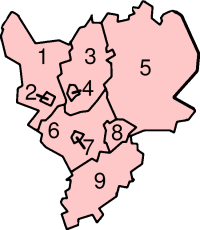 |
Derbyshire | 1. Derbyshire | a.) High Peak, b.) Derbyshire Dales, c.) South Derbyshire, d.) Erewash, e.) Amber Valley, f.) North East Derbyshire, g.) Chesterfield, h.) Bolsover |
| 2. Derby U.A. | |||
| Nottinghamshire | 3. Nottinghamshire | a.) Rushcliffe, b.) Broxtowe, c.) Ashfield, d.) Gedling, e.) Newark and Sherwood, f.) Mansfield, g.) Bassetlaw | |
| 4. Nottingham U.A. | |||
| Lincolnshire (part only) |
5. Lincolnshire | a.) Lincoln, b.) North Kesteven, c.) South Kesteven, d.) South Holland, e.) Boston, f.) East Lindsey, g.) West Lindsey | |
| Leicestershire | 6. Leicestershire | a.) Charnwood, b.) Melton, c.) Harborough, d.) Oadby and Wigston, e.) Blaby, f.) Hinckley and Bosworth, g.) North West Leicestershire | |
| 7. Leicester U.A. | |||
| 8. Rutland | |||
| 9. Northamptonshire | a.) South Northamptonshire, b.) Northampton, c.) Daventry, d.) Wellingborough, e.) Kettering, f.) Corby, g.) East Northamptonshire | ||
MEPs
The East Midlands is also a five-member constituency for the European Parliament.
Economy
Manufacturing
_tests_an_aircraft_jet_engine_for_defects_while_performing_Jet_Engine_Test_Instrumentation,_(JETI)_Certification-Engine_Runs.jpg)
In 2003, 23% of economic output in the East Midlands was in manufacturing, compared to 15% in the UK.
Main employers in the region include Weetabix at Burton Latimer. For engineering, there is Rolls-Royce in Sinfin in Derby, Siemens in Lincoln, Triumph Motorcycles and Ultima Sports in Hinckley, Cummins in Daventry, Cosworth in Northampton, Brawn GP in Brackley, JCB in Foston, Derbyshire, Noble in Barwell, Toyota Manufacturing UK on an old airfield at Burnaston, and Caterpillar has a large factory on an old airfield near Desford; the site is also used by Massey Ferguson for their spares division factory. DeltaRail Group is in Derby and Bombardier UK (former BREL then ABB Adtranz) is Britain's only train manufacturer left, and is in Litchurch. Mountsorrel has the largest granite quarry in Europe, owned by the French company, Lafarge (owned by Redland plc until 1997). BPB plc, the world's largest manufacturer of plasterboard who own British Gypsum, is based in East Leake, Nottinghamshire. Artex Ltd., part of the same company, is in Ruddington. Raleigh Bicycle Company, although has had its manufacturing in the Far East for over ten years, is based in Eastwood; its former site on Triumph Road is now the quirkily-designed Jubilee Campus of the University of Nottingham which has the UK's tallest (52 metres) sculpture, Aspire.
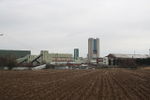
FKI who own Brush Electrical Machines is in Loughborough, home to the United Kingdom Energy Technologies Institute and John Taylor & Co, which although entering administration in 2009, is the largest bell foundry in the world. Ferodo is in Chapel-en-le-Frith, who have made brake pads since its founder Herbert Frood invented them in Combs in 1897. Aggregate Industries is based in Bardon. The north part of Derbyshire and Nottinghamshire used to have many coal mines, and there are two pits still producing in Nottinghamshire near Market Warsop and Ollerton; UK Coal is based in Harworth. Swarfega was invented and is made by Deb in Belper. Corus Tubes are in Corby. The Alumasc Group is in Burton Latimer. NSK Ltd. has a bearings factory in Newark-on-Trent. The Motor Industry Research Association has an important test track at Higham on the Hill near Hinckley. Heckler & Koch UK is in Lenton. Timsons make printers in Kettering.
Retail
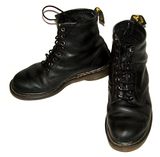
Thorntons is a big employer at Alfreton, and Wilkinson is at Worksop. In Lenton, are the head offices of Games Workshop, the producers of Warhammer miniatures and the fashion company Paul Smith. The lingerie companies Gossard, Aristoc, Pretty Polly, and Berlei (formerly owned by Courtaulds) are based in Daybrook. Speedo is in Bobbers Mill on the A610 near Basford. Its LZR Racer suit helped Michael Phelps win eight golds at the 2008 Olympics. It is moving to the ng2 business park on Queens Drive (near Experian) in 2010. Pendragon PLC, the car dealership and the Sherwood Park industrial area is in Annesley. Silver Spoon makes all of its demerara and brown sugar at Newark, although the Tate & Lyle site may be closing. Dunelm Mill, the furnishings company, is based in Syston, as is Pukka Pies. Many footwear companies such as Shoe Zone (which bought out Stead and Simpson), are based in Leicester, as is the clothing company, Next, the photographic equipment company Jessops, and Fox's Confectionery (maker of Fox's Glacier Mints and not named after the locally-significant animal, with all three are based near each other on the Braunstone Frith estate). Also in Leicester are the bookmaker Mark Jarvis, the BSS Group, the European HQ of National Car Rental, Otis UK (lifts), and Admiral Sportswear. Jacobs is on the Meridian Business Park in Braunstone, next to the M1.
The crisp company Walkers (owned by PepsiCo and the UK's biggest grocery brand) makes 10 million bags of crisps a day, using 280,000 tonnes of potatoes a year, at the biggest crisp factory in the world at Beaumont Leys; nearby is Taylor Bloxham, the lithographic printers. Brantano Footwear UK, based in Leicester before 2002, is in Ellistown and Battleflat just south of Coalville near M1 junction 22. Hammonds, the furniture company, is in Hinckley. Swizzels Matlow makes children's confectionery in New Mills. Carlsberg has been brewed in Northampton since 1974, and also brews Holsten Pils, and will brew Tetley from 2011. Blacks Leisure Group (owner of Blacks and Millets) is based in Duston, to the west of the town; and there is Travis Perkins who also own Wickes. Avon Products UK is also in Northampton. East Midlands Trains has its head office in Derby. The former East Midlands Electricity is now owned by E.ON UK (supply) and Central Networks East (distribution), since Powergen bought EME in June 1998, which is based in Long Whatton and Diseworth. Nearby at Castle Donington is the home of the (separate) headquarters of BMI (in Donington Hall) and bmibaby.

Cott Beverages UK is in Kegworth. Sports Direct is based in Shirebrook on an old Bolsover coal mine. Sixt, the car rental firm, has its UK base in Chesterfield. Global Brands (maker of Vodka Kick and Corky's) is based in Clay Cross. Greencore UK is in Barlborough. United Biscuits has a main factory in Ashby-de-la-Zouch where it makes its KP Snacks. Oxo and Bisto is made by Premier Foods in Worksop. Cat food such as Whiskas is made in Melton Mowbray by Masterfoods. Alpro UK is in Kettering. Dr. Martens are made in Wellingborough, also home of Booker Group, the Cash & Carry. Topps Tiles are based in Enderby. Whitworths, the food company, is in Irthlingborough. Maclaren, the pushchair maker, is in Long Buckby. There are three main distribution centres in the area at Magna Park in Leicestershire (the largest of its kind in Europe), and Brackmills and the Daventry International Railfreight Terminal in Northamptonshire.
Healthcare

Boots is based in Lenton in Nottingham, who developed Ibuprofen in the 1960s, as is Vision Express. Crookes Healthcare, formerly Boots and now Reckitt Benckiser, make Strepsils and Optrex on the enormous Boots site. On the ng2 business park, Specsavers have their corporate eyecare and contact lens division. Three out of the four main UK opticians are sited in Nottingham. The MRI scanner was developed at the University of Nottingham, and next door, Queen's Medical Centre (QMC) is the largest teaching hospital in Europe, and the largest hospital in the UK. EMAS is based in Bilborough on the A6002 near junction 26 of the M1. There are three (charity-funded) air ambulance services: the western one is based at EMA, the eastern one is based at RAF Waddington, and the southern one (shared with Warwickshire) is at Coventry Airport. NHS East Midlands is at Sandiacre next to junction 25 of the M1. AstraZeneca have their Charnwood R&D site in Loughborough, which was owned by Fisons before 1995, when it was bought by Astra.
High technology
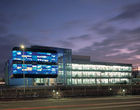
Belkin UK is in Rushden, RS Components in Corby and Pegasus Software is in Kettering. Serif Europe is in West Bridgford. BioCity in Nottingham is an important centre for cutting-edge bioscience companies. AVG Technologies has its UK head office on Newark's industrial estate.
Finance
Capital One, the Virginia-based credit card company, has its UK HQ in Nottingham's city centre next to the train station, and Dublin-based Experian, one of two UK credit-referencing companies, was founded and has a large UK HQ to the south-west of the city, on the A453 near the River Trent. Alliance & Leicester is based in Narborough. Barclaycard is headquartered in Northampton, and Nationwide has a large administrative centre at Moulton Park. Egg Banking is on Pride Park in Derby.
Rural
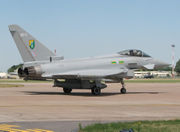
Lincolnshire and Rutland are very agricultural, with much of the UK's arable crops grown in this area. Leicester's Walkers Crisps are made exclusively from potatoes grown in Lincolnshire. The RAF have many bases in this area too, with the main RAF College at Cranwell near Sleaford. Interflora has its UK HQ in Sleaford. Fowler-Welch Coolchain are based in Spalding, as is the UK operation of Bakkavör (former Geest) which is the UK's largest provider of fresh prepared foods. Premier Foods have a large operation in Little Sutton near to Long Sutton. Silver Spoon's Bardney plant makes the market-leading Askey's dessert toppings. John Deere have their UK base at Langar on the Nottinghamshire/Leicestershire boundary next to the former RAF Langar.
Entertainment
_at_Twycross_Zoo-4.jpg)
Skegness and the Lincolnshire coast provides seaside entertainment for many people in the East Midlands with its Butlins resort. Nottingham and Leicester are a popular night time destination (often for people outside of the East Midlands). Center Parcs UK is based in New Ollerton. The YHA is based in Matlock. Gala Bingo is based in Nottingham. Twycross Zoo is just south of Measham in Leicestershire, and the National Space Centre is in Belgrave in north Leicester.
Rockingham Motor Speedway is in Corby, and other racetracks include Donington Park and Mallory Park in Leicestershire, and Cadwell Park in Lincolnshire. Silverstone Circuit hosts the British Grand Prix, although the southern half of the track is outside the region. Rutland Water is popular for sailing, fishing and bird-watching. The Peak District is the second most popular national park in the world after Mount Fuji.
Education
There is a mixture of education across the East Midlands - mostly comprehensive secondary schools, except Lincolnshire has fifteen state grammar schools (as well as some comprehensive schools). For GCSE results, City of Nottingham schools are the worst performing, with Leicester schools a close second. Rutland (the best area for GCSEs) has one of the highest percentages of pupils (Buckinghamshire is the highest) reaching the threshold of five grades A-C (including Maths and English) in England, although the highest performing district council area is Rushcliffe. Lincolnshire performs the best for conventional counties (by some distance); Leicestershire and Derbyshire also have GCSE results above the UK average. Nottingham and Leicester school children are the least likely to pass any GCSEs, with Nottingham one of the highest amounts in England.
At A level, Nottingham performs the best (due to half of Nottingham's A-level candidates going to the excellent Bilborough College), and with schools in Lincolnshire and Derbyshire, has results above the UK average; Nottingham has much better results at A level than those at GCSE on average. This describes the city quite accurately - it has the largest group of under-achieving school pupils in the East Midlands, but yet has one of the highest achieving groups of school pupils as well, giving a salient socio-economic diversity of almost chasmic proportions. Northamptonshire gets the lowest results at A level.
There are eighteen further education colleges in the region - the main three are Castle College Nottingham, Lincoln College, and New College Nottingham. School children in Rutland, and then Leicestershire are most likely to attend university.
Top twenty state schools in the East Midlands (2009 A level results)

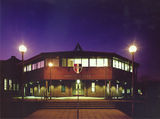
- 1. Caistor Grammar School (1068)
- 2. The Becket School, West Bridgford
- 3. Spalding High School
- 4. Bourne Grammar School
- 5. St Mary's Roman Catholic High School, Chesterfield
- 6. Kesteven and Grantham Girls' School
- 7. The King's School, Grantham
- 8. Queen Elizabeth's Grammar School, Horncastle
- 9. Northampton School For Boys
- 10. The Priory Lincolnshire School of Science and Technology, Lincoln
- 11. Queen Elizabeth's Grammar School, Ashbourne
- 12. Kesteven and Sleaford High School
- 13. Skegness Grammar School
- 14. Queen Elizabeth's High School, Gainsborough
- 15. Bilborough College
- 16. West Bridgford School
- 17. William Farr School, Welton
- 18. Friesland School, Sandiacre
- 19. Lady Manners School, Bakewell
- 20. The Deepings School, Deeping St. James (881)
Universities

Main universities in the region include:
- University of Nottingham - also has the Sutton Bonington campus housing the regions's only vet school and the region's biggest university with around 33,000 students, and receives almost twice as much funding in total than any other university in the region, due to its large research grant. Leicester and Loughborough have about half as much in research grants, and have roughly equal numbers of students, and again half that of Nottingham.
- Loughborough University - equally famous for its sporting heritage as well as its academic work, producing the lifeblood of British athletics, such as Paula Radcliffe. The British Olympic athletics team will be training there before the 2012 Games.
- University of Leicester - famous for Alec Jeffreys and DNA profiling, and is known for its astronomy work
- Nottingham Trent University (NTU) - also has the Brackenhurst campus, and the region's second biggest university
- De Montfort University (DMU) - the region's third biggest university. It used to have campuses outside the region at Bedford until 2006, and at Milton Keynes until 2003.
The region has one university college - the Bishop Grosseteste University College Lincoln, essentially a teacher training college. The region has the lowest proportion of part-time students in England. The region 'imports' more young people into the region at the university stage than it 'exports' into other regions' universities: it is a net provider for other regions (similar to the North East, and Yorkshire and the Humber). Only 25% of the region's first degree students are native to the region, 14% are from the East of England, 12% from South East England, and 11% from the West Midlands. Hardly any are from Scotland, Wales or the North East. 15% are from the North of England. For all first-degree students native to the region, 35% stay in the region, 18% go to Yorkshire and the Humber, 10% to North West England, and 9% to the West Midlands. Very few go to to Scotland, but more than twice as many East Midlands students study in the North East than vice-versa. Just over 15% of the region's native students study in the South of England, with around 45% staying in the Midlands, and 34% go to the North of England.
Once graduated, more graduates from East Midlands universities leave the region than stay to find work. Graduate work is more likely to be found in other regions with 35% going to the South of England - around the same proportion of students studying in the region from the South of England.
Local media
Television
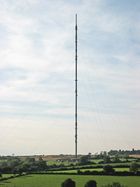
- The BBC East Midlands region of BBC Television, based in Nottingham, produces several regional television programmes including the news programme East Midlands Today. This excludes most of Northamptonshire, north Nottinghamshire and north Derbyshire. Most of Lincolnshire is covered by the BBC Yorkshire and Lincolnshire region based in Hull, with its Look North programme. Derbyshire's High Peak is covered by BBC North West and Granada Television based in Manchester. Northamptonshire is part of the BBC East region based in Norwich and has the Look East programme. Most of Northamptonshire can receive Central News East, with western parts of the county (Daventry) receiving Central News West, and Southern parts of the county (around Brackley, Towcester and Northampton) receiving Thames Valley Tonight, which used to be the Central south region. Central News East also covered the East Midlands, broadcasting from Lenton Lane in Nottingham from March 1984. The studios were closed and is now the King's Meadow Campus of Nottingham University. These studios had been responsible for Family Fortunes and Who Wants to Be a Millionaire?. Central News East still continues, broadcasting from ITV Central's Birmingham Studios. Northamptonshire has Anglia Television's Anglia Tonight programme and most of Lincolnshire and Nottinghamshire (excluding south Nottinghamshire) has Yorkshire Television's Calendar.
- MATV, based in Leicester, which caters to the area's large South Asian population.
Radio
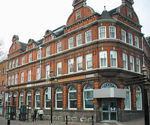
- BBC Radios Derby, Leicester, Lincolnshire, Northampton, Nottingham, Manchester (for Glossop, Whaley Bridge and Chapel-en-le-Frith) and Sheffield (for Chesterfield). BBC Radio Leicester was the first local radio station in the United Kingdom.
- Many commercial radio stations: Leicester Sound, Trent FM (Nottingham) RAM FM (Derby and Burton-on-Trent), Heart 106 (Derbyshire, Nottinghamshire and Leicestershire), Peak FM (Chesterfield and North Derbyshire), Lincs FM (Lincolnshire and Newark-on-Trent), Oak FM (Loughborough and Hinckley), Rutland Radio, Boundary Sound (Newark), Mansfield 103.2 FM, Trax FM (Bassetlaw), High Peak Radio (Chapel-en-le-Frith), Heart 96.6 (Northamptonshire), Connect 97.2 & 107.4 (Corby, Kettering & Wellingborough), Sabras Radio, Hindu Sanskar Radio and 106.6 Smooth Radio (Derbyshire, Leicestershire, Lincolnshire and Nottinghamshire).
Newspapers
There are several newspapers, the largest of which include:- Derby Telegraph, Derbyshire Times, Leicester Mercury, Lincolnshire Echo, Northampton Chronicle and Echo, and Nottingham Evening Post. The main daily newspapers in the region are all published by Northcliffe Media.
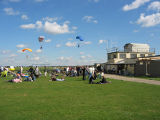
Magazines
There are many regional lifestyle publications, the largest and most widely read being: Life&Style Magazine, FHP Magazine, Nottinghamshire Life and City Life and County Living.
See also
- List of schools in the East Midlands
- Scouting in East Midlands
- East Midlands Regional Select Committee
- South Midlands, a name for the southern part of the East Midlands.
References
- ↑ http://www.highways.gov.uk/roads/projects/4403.aspx A46 improvement
- ↑ "Regional Transport Strategy: the National Picture". Government Office for the East Midlands. http://www.gos.gov.uk/goem/transport/regtransstrategy/?a=42496. Retrieved 2009-05-07.
- ↑ "The LTP Process". Department for Transport. http://www.dft.gov.uk/pgr/regional/ltp/theltpprocess. Retrieved 2009-05-07.
- ↑ "Derbyshire 2006-11 Local Transport Plan". Derbyshire County Council. http://www.derbyshire.gov.uk/transport_roads/transport_planning/. Retrieved 2009-05-07.
- ↑ "Leicestershire 2006-11 Local Transport Plan". Leicestershire County Council. http://www.leics.gov.uk/index/highways/transport_plans_policies/ltp/ltp2_summary.htm. Retrieved 2009-05-07.
- ↑ "Lincolnshire 2006-11 Local Transport Plan". Lincolnshire County Council. http://www.lincolnshire.gov.uk/section.asp?sectiontype=fileattachment&catid=2225&docid=41750. Retrieved 2009-05-07.
- ↑ "Northamptonshire 2006-11 Local Transport Plan". Northamptonshire County Council. http://www3.northamptonshire.gov.uk/Transport/TP/LTP/ltp06-11.htm. Retrieved 2009-05-07.
- ↑ "Nottinghamshire 2006-11 Local Transport Plan". Nottinghamshire County Council. http://www.nottinghamshire.gov.uk/home/traffic_and_travel/strategy-policy/ltp.htm. Retrieved 2009-05-07.
- ↑ "Rutland 2006-11 Local Transport Plan". Rutland County Council. http://www.rutland.gov.uk/pp/gold/viewgold.asp?idtype=page&id=9664. Retrieved 2009-05-07.
- ↑ "Derby 2006-11 Local Transport Plan". Derby City Council. http://www.derby.gov.uk/TransportStreets/TransportPlanning/DerbyLJTP06-11/DJLTP-06-11.htm. Retrieved 2009-05-07.
- ↑ "Leicester 2006-11 Local Transport Plan". Leicester City Council. http://www.leicester.gov.uk/your-council--services/transport--traffic/transportpolicy/transport-plan/second-local-transport-plan. Retrieved 2009-05-07.
- ↑ "Nottingham 2006-11 Local Transport Plan". Nottingham City Council. http://www.nottinghamcity.gov.uk/index.aspx?articleid=848. Retrieved 2009-05-07.
- ↑ http://www.hefce.ac.uk/pubs/hefce/2007/07_18/outputEM.pdf HEFCE
- ↑ Communities and Local Government 2007
- ↑ LSOA deprivation data
- ↑ North-south divide
- ↑ [http://news.bbc.co.uk/1/shared/election2010/results/region/1.stm East Midlands 2010 General Election BBC
External links
- East Midlands Development Agency
- East Midlands Regional Assembly
- Government Office for the East Midlands
- Regional Development Fund
- Government's list of councils in the East Midlands
- East Midlands Innovation
- East Midlands New Technology Initiative
- East Midlands Universities Association
|
|||||
|
|||||
|
|||||||||||||||||||||||||||||||||||||||||||||||
